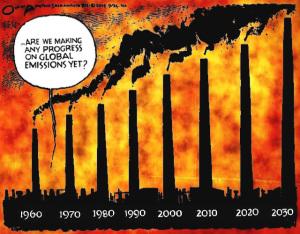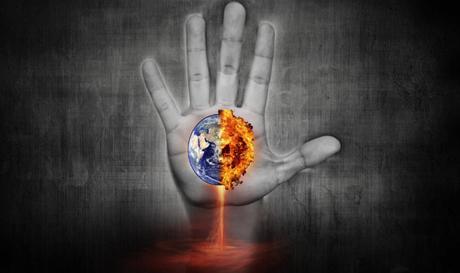GR: I read an interesting article by Richard Heinberg published on the Post Carbon Institute website on Thursday. The article offers two responses to the coming crash that improve our chances for surviving The solutions are quite clearly presented and I think you will agree with me that they make sense.
 The crash will occur because our energy-dependent industrialized societies cannot sustain their current level of energy consumption. As Heinberg points out, it is possible to live a good life on a smaller energy budget. And this means that our civilization can survive a major reset without total failure. My only quibble with the article is that Heinberg seems to assume that carbon emissions have begun to fall. We just learned that this isn’t true. This is a problem we need to deal with now.
The crash will occur because our energy-dependent industrialized societies cannot sustain their current level of energy consumption. As Heinberg points out, it is possible to live a good life on a smaller energy budget. And this means that our civilization can survive a major reset without total failure. My only quibble with the article is that Heinberg seems to assume that carbon emissions have begun to fall. We just learned that this isn’t true. This is a problem we need to deal with now.
Heinberg explains that the reason the coming crash threatens our survival is that our society is too dependent on growth. If growth fails, we crash. Growth is going to fail because of climate change, energy resource limits, the increase in the food required by our growing population, soil erosion, deforestation, species extinctions, declining fresh water, ocean acidification, and our fragile economic system.
Heinberg’s crash responses control the crash so that civilization can recover at lower population and consumption levels. Clearly, there is no certainty that civilization will survive. Nevertheless, planning ahead for the post-crash recovery is a rational response that delivers a valid hope for our future.
“Among those who understand the systemic nature of our problems, the controlled crash option is the subject of what may be the most interesting and important conversation that’s taking place on the planet just now. But only informed people who have gotten over denial and self-delusion are part of it.”
Here’s a bit more of Heinberg’s article:

Are We Doomed? Let’s Have a Conversation.
“Are we doomed if we can’t maintain current and growing energy levels? And are we doomed anyway due to now-inevitable impacts of climate change?
“First, the good news. With regard to energy, we should keep in mind the fact that today’s Americans use roughly twice as much per capita as their great-grandparents did in 1925. While people in that era enjoyed less mobility and fewer options for entertainment and communication than we do today, they nevertheless managed to survive and even thrive. And we now have the ability to provide many services (such as lighting) far more efficiently, so it should be possible to reduce per-capita energy usage dramatically while still maintaining a lifestyle that would be considered more than satisfactory by members of previous generations and by people in many parts of the world today. And reducing energy usage would make a whole raft of problems—climate change, resource depletion, the challenge of transitioning to renewable energy sources—much easier to solve.
“The main good news with regard to climate change that I can point to (as I did in an essay posted in June) is that economically recoverable fossil fuel reserves are consistent only with lower-emissions climate change scenarios. As BP and other credible sources for coal, oil, and natural gas reserves figures show, and as more and more researchers are pointing out, the worst-case climate scenarios associated with “business as usual” levels of carbon emissions are in fact unrealistic.
“Now, the bad news. While we could live perfectly well with less energy, that’s not what the managers of our economy want. They want growth. Our entire economy is structured to require constant, compounded growth of GDP, and for all practical purposes raising the GDP means using more energy. While fringe economists and environmentalists have for years been proposing ways to back away from our growth addiction (for example, by using alternative economic indices such as Gross National Happiness), none of these proposals has been put into widespread effect. As things now stand, if growth falters the economy crashes.
“There’s bad climate news as well: even with current levels of atmospheric greenhouse gases, we’re seeing unacceptable and worsening impacts—raging fires, soaring heat levels, and melting icecaps. And there are hints that self-reinforcing feedbacks maybe kicking in: an example is the release of large amounts of methane from thawing tundra and oceanic hydrates, which could lead to a short-term but steep spike in warming. Also, no one is sure if current metrics of climate sensitivity (used to estimate the response of the global climate system to a given level of forcing) are accurate, or whether the climate is actually more sensitive than we have assumed. There’s some worrisome evidence the latter is case.
“But let’s step back a bit. If we’re interested in signs of impending global crisis, there’s no need to stop with just these two global challenges. The world is losing 25 billion tons of topsoil a year due to current industrial agricultural practices; if we don’t deal with that issue, civilization will still crash even if we do manage to ace our energy and climate test. Humanity is also over-using fresh water: ancient aquifers are depleting, while other water sources are being polluted. If we don’t deal with our water crisis, we still crash. Species are going extinct at a thousand times the pre-industrial rate; if we don’t deal with the biodiversity dilemma, we still crash. Then there are social and economic problems that could cause nations to crumble even if we manage to protect the environment; this threat category includes the menaces of over-reliance on debt and increasing economic inequality.
“If we attack each of these problems piecemeal with technological fixes (for example, with desalination technology to solve the water crisis or geo-engineering to stabilize the climate) we may still crash because our techno-fixes are likely to have unintended consequences, as all technological interventions do. Anyway, the likelihood of successfully identifying and deploying all the needed fixes in time is vanishingly small.” –Richard Heinberg (Continue reading: Are We Doomed? Let’s Have a Conversation. Post Carbon Institute).

